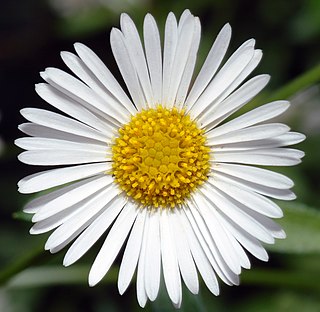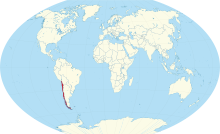
Baccharis is a genus of perennials and shrubs in the aster family (Asteraceae). They are commonly known as baccharises but sometimes referred to as "brooms", because many members have small thin leaves resembling the true brooms. They are not at all related to these however, but belong to an entirely different lineage of eudicots. B. halimifolia is commonly known as "groundsel bush", however true groundsels are found in the genus Senecio.

Bedfordia is a genus of flowering plants belonging to the family Asteraceae. The genus includes 3 species, all endemic to Australia.

Baccharis linearis, the romerillo or Chilean little rosemary, is a common shrub in Central Chile. It is frequently found in old field after agriculture. Cecidia or galls caused by the fruit fly Rachiptera limbata grow as white, spongy and globose tissues on the twigs of the plant.

Asteriscus is a genus of flowering plants in the family Asteraceae.

Erigeron karvinskianus, the Mexican fleabane, is a species of daisy-like flowering plant in the family Asteraceae, native to Mexico and parts of Central America.
Anaxeton is a genus of flowering plants in the family Asteraceae.

Corethrogyne is a monotypic genus of flowering plant in the family Asteraceae. Its only species is Corethrogyne filaginifolia, known by the common names common sandaster and California aster.

Amblyolepis is a genus of flowering plants in the daisy family described as a genus in 1836.
Dubyaea is a genus of Asian flowering plants in the family Asteraceae, primarily from China.

Flourensia is a genus of flowering plants in the family Asteraceae. It contains subshrubs and shrubs, which are commonly known as tarworts. They are found in the southwestern United States, Mexico, Central America, and South America. The genus name honours French physiologist Jean Pierre Flourens (1794–1867).
Gymnolaena is a genus of Mexican flowering plants in the family Asteraceae.

Leptocarpha is a monotypic genus of flowering plants in the family Asteraceae. It is endemic to central Chile.

Chionolaena is a genus of flowering plants in the family Asteraceae. It is native to tropical and subtropical regions in the Americas, with species occurring discontinuously from central Mexico to southern Brazil. About half occur in southeastern Brazil.

Pomaderris intermedia, commonly known as lemon dogwood, is a species of flowering plant in the family Rhamnaceae and is endemic to south-eastern Australia. It is a shrub with hairy stems, elliptic to egg-shaped leaves, and clusters of yellow flowers.

Micropsis is a genus of South American flowering plants in the family Asteraceae.
Chromolaena macrodon is a rare Caribbean species of flowering shrub in the family Asteraceae. It is found only the Island of Dominica in the Lesser Antilles.
Chromolaena squalida is a South American species of flowering shrub in the family Asteraceae. It is found in Brazil, Paraguay, Bolivia, Peru, Colombia, Venezuela, Guyana, Suriname.

Passiflora subg. Astrophea is a group of Passiflora species that are lianas, shrubs and trees found in South America.

Pyrrhopappus pauciflorus, commonly known as smallflower desert-chicory, Texas false dandelion or Texas dandelion, is a species of flowering plant in the family Asteraceae. It is native to the southern United States and northern Mexico. It is a weedy annual found in prairies, clay soils and disturbed habitats such as fields and sidewalks.

Baccharis macraei is a species of shrub native to Chile and Peru.















